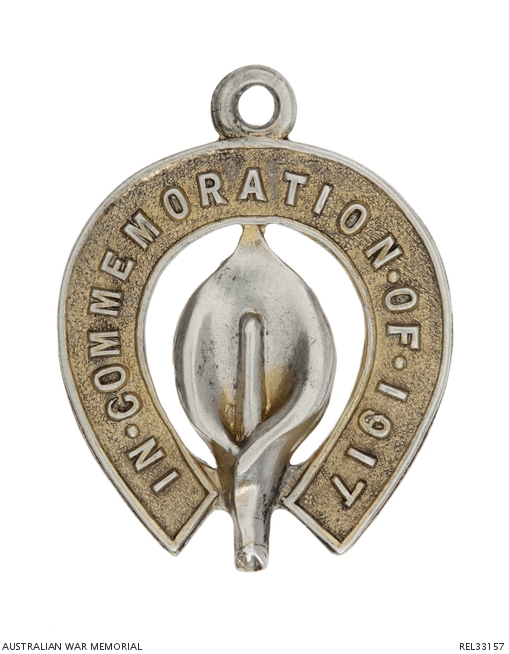| Place | Oceania: Australia, New South Wales, Sydney |
|---|---|
| Accession Number | REL33157 |
| Collection type | Heraldry |
| Object type | Medalet |
| Physical description | Sterling silver |
| Location | Main Bld: First World War Gallery: Western Front 1916: Homefront |
| Maker |
Trantum |
| Place made | Australia: New South Wales, Sydney |
| Date made | c 1917 |
| Conflict |
First World War, 1914-1918 |
Lily White Association Commemorative medalet, 1917 New South Wales General Strike

Sterling silver medalet in the shape of a horseshoe with a lily in the centre. In raised relief around the shoe are the words 'IN.COMMEMORATION.OF.1917'. The reverse is marked 'REG 2771 STG SIL' with the maker's details 'TRANTUM' and the impressed serial number '714'.
In August 1917 the New South Wales Railway Department workshops at Eveleigh became the centre of a general strike which crippled, amongst others, the transport, waterside, gas and coal industries. The railwaymen called a strike to protest the introduction of a 'time card' system which recorded how long it took men to perform tasks in the workshop. The workers believed it was aimed at speeding up their productivity and were worried about an increase in accidents. Rail-borne goods became 'black' for members of many other unions and coal miners, lumpers and waterside workers who were unionists refused to handle goods on and off the trains. Ports around Australia virtually ceased operations, crippling shipping. Other industries also participated in the strike which, for the railways, lasted six weeks. The coal and waterside workers took longer to settle their disputes. During the strike the railwaymen and their families suffered great hardship and the wide spread use of 'scabs' to do the work, including schoolboys from Sydney Grammar, eventually led to the defeat of the strike. 3000 unionists were denied reemployment with the Railway Department and others who were taken back were demoted. One of these was Ben Chifley, an engine driver and union leader who was demoted to fireman. His experiences in the union and during the strike inspired his political career and he served as Australian Prime Minister from 1945-49. He was one of the railwaymen who had the right to wear this badge organised by the 'Lily White' Association and identified those workers who refused to go back to work for the duration of the strike.